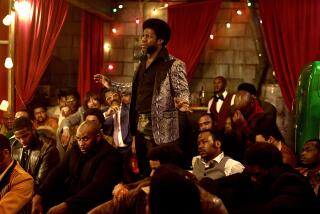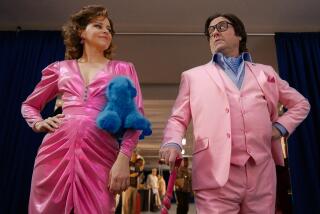‘Thrilla in Manila’ on HBO
- Share via
If you are not a boxing fan (I am not a boxing fan), the HBO documentary “Thrilla in Manila” -- the story of the Joe Frazier-Muhammad Ali rivalry, as it played across three fights from 1971 to 1975 -- is not the film to make you one. And if you are a boxing fan, well, even those here seem appalled at the brutality of the famous final bout, called one of the greatest fights in history, even as they celebrate the participants’ gladiatorial resolve. But either way, the movie works.
History is written not only by but for the winners, and what Ali has not celebrated about himself the world has celebrated for him; he’s as famous as anyone has ever been, and as beloved. Frazier, 63 at the time of filming, was living in a room at his Philadelphia gym.
But Ali doesn’t come off all that well here. Part of it is context -- directed by John Dower, “Thrilla” is really a film about Frazier -- and part is just focus: Ali did behave badly toward Frazier, his customary brashness escalating to a calculated nastiness, and though he apologized publicly in later years, he never apologized directly to Frazier.
Ali not only called Frazier stupid and ugly, but, more provocatively, an Uncle Tom. “He’s the other type of Negro,” said Ali. “He’s not like me.” Frazier worked “for the enemy” -- he was backed by a consortium of white Philadelphia businessmen, while Ali was supported by the Nation of Islam. That Frazier had supported Ali -- financially, vocally, morally -- when Ali’s refusal to serve in the U.S. Army lost him his title and boxing license in 1967 (a Supreme Court ruling restored it in 1970), made these attacks all the more galling.
Their first meeting, in Madison Square Garden, was dubbed “The Fight of the Century” -- it was the first fight between two unbeaten champions -- and was a celebrity-studded affair in which Frank Sinatra shot photos for Life and Burt Lancaster did color commentary. By the time they met in Manila, Frazier had lost his crown to George Foreman, who in turn lost it to Ali.
It was a grasshopper-and-ant scenario. Ali did not expect Frazier to be much trouble. Possibly for the sake of the rhyme, and possibly for the sake of the racial overtones, he derided Frazier continually as a gorilla -- “It’ll be a thriller, and a killer, and a chiller when I get that gorilla in Manila” -- sparring for the cameras with a man in a gorilla suit. Frazier took himself out of town to concentrate.
The fight when it came was vicious, the advantage swinging first to Ali, and then to Frazier. “He wasn’t just beating Ali,” observes one sportswriter. “He was beating Ali up.” But Frazier, who already had only partial sight in his left eye, was losing it in his swelling right: After awhile, he couldn’t see the punches coming. Both fighters, says Ali’s former doctor Ferdie Pacheco, had reached the point “when the fight becomes more important than life and death, and that’s why people die in boxing.”
“Thrilla in Manila” is a compelling, often-disturbing story about former friends locked in permanent clinch in which the greatness of each is reckoned by the greatness of the other and by the mutual damage they’ve done. The camera watches Frazier watching footage of Manila for the first time, and he does not look like a man looking at himself lose.
“God marks it down,” says Frazier of Ali’s behavior to him; he is willing to see Ali’s Parkinson’s as divine retribution and likes to think of himself as its earthly instrument: “I’m the guy who closed down the butterfly lips.”
More to Read
The biggest entertainment stories
Get our big stories about Hollywood, film, television, music, arts, culture and more right in your inbox as soon as they publish.
You may occasionally receive promotional content from the Los Angeles Times.











